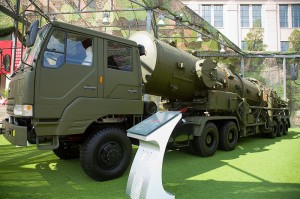A new weapon in the Chinese military arsenal is said to be causing a stir in the U.S. Navy: the Dongfeng 21D anti-ship ballistic missile (ASBM). Some experts are calling it a “game changer” because the missile is the first ballistic missile with the capability to take out a moving aircraft carrier. Because it’s ballistic it can travel at incredible speeds: this missile reportedly clocks in close to an astounding Mach 10!
Says the U.S. Naval Institute blog:
The size of the missile enables it to carry a warhead big enough to inflict significant damage on a large vessel, providing the Chinese the capability of destroying a U.S. supercarrier in one strike.
Because the missile employs a complex guidance system, low radar signature and a maneuverability that makes its flight path unpredictable, the odds that it can evade tracking systems to reach its target are increased. It is estimated that the missile can travel at Mach 10 and reach its maximum range of 2000km in less than 12 minutes.
The Associated Press wrote a breathless report on the missile this month, and some have chimed in to say that with the development of the Dongfeng 21D the U.S. has lost its supremacy of the sea. Others aren’t so sure.
I’m sort of in the middle on this issue. It’s well-known that the Chinese are working to build a blue water navy but such huge leaps don’t come overnight, even to a country growing as rapidly as China. And while some may say this missile ups the ante, a missile is not the same thing as sea power.
Secondly, carriers became outdated with the development of the cruise missile. They’re big, expensive, lumbering, and manpower-intensive. Carrier technology, with the exception of their nuclear power plants, really hasn’t changed since World War II. It’s my opinion that a carrier’s biggest asset lies in its ability to show the flag. It’s the projection of power. Carriers play the role that big battleships used to play. But like the battleships before it, carriers are also doomed to obsolescence.
About the time I was leaving the Navy, there were those who envisioned the modern fleet would consist of inexpensive floating missile barges.These arsenal ships with virtually no superstructure and only the smallest of crews. While that approach is quite effective, it isn’t sexy. It doesn’t get recruits in the doors, or get Congress writing checks (nor generate as many construction jobs, I might add). So the carrier’s message is as much for our side as it is for the enemy’s.
Then there are our wonderful fleet of submarines. Subs, you might be aware, are the ultimate military weapon: silent, deadly, and capable of hiding completely for months on end. Good luck on finding one, and if you do then good luck on attacking it with a missile.
Pretty much, should a missile from China or anywhere else take a shot at one of our aircraft carriers, the gloves will come off. The incoming missile may as well be nuclear-tipped because there will be no second chance: there will be hell to pay. Ballistic missile launches provide a nice, easily-detectable heat signature, so there will be no secret about where they originated.
Fortunately, China isn’t stupid and wouldn’t endanger the trade and business relationships that have benefited both countries tremendously over the years. Thus I think these threats are overblown and offer little more than bragging rights. Will this missile radically alter how the U.S. Navy operates? I seriously doubt it.

It goes Mach 10, and it’s ballistic, but has a non-predictable path?
That doesn’t add up in my head
I haven’t downloaded the full DoD report on the missile, but supposedly it does its juking upon or after reentry. So it’s more than a falling rock, from what I can tell.